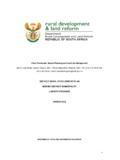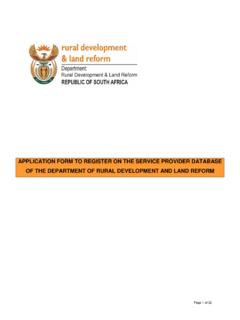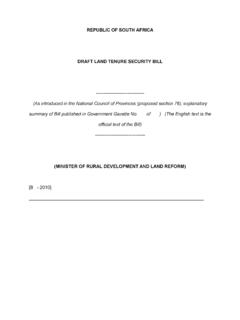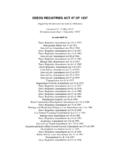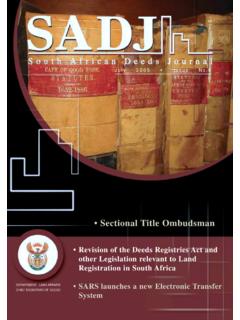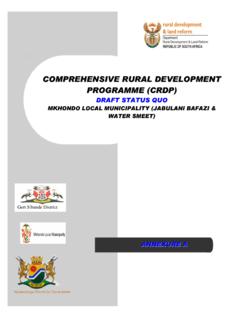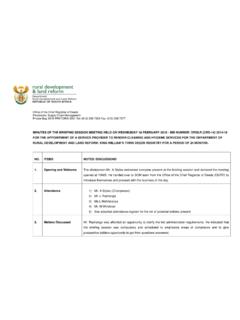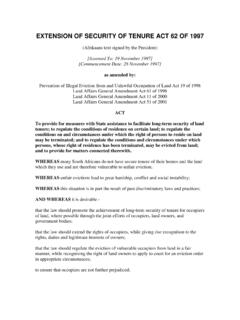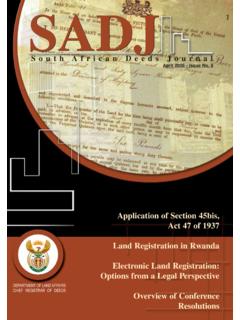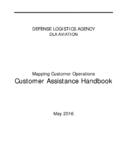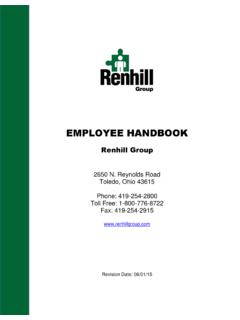Transcription of Version 1 - Minister of Rural Development and Land …
1 DLA handbook ON PROPERTY VALUATION May 2000 Version 1 DLA handbook on Property Valuation Contents Preface .. 1 1 Standard Terms of Reference for Professional Valuations .. 2 2 Summary of Relevant Land Reform Policies and Legislation .. 7 Valuation of land under Act 126 .. 7 Valuation of land under the Restitution Act .. 8 Valuation of land under the Labour Tenants Act .. 8 Valuation of land under the ESTA .. 9 Valuation of land in connection with state land disposal .. 9 3 General Principles and the Interpretation of 25(3) of the Constitution .. 10 Introduction .. 10 Valuation as a two-step process.
2 11 Confirmation that the Pointe Gourde principle applies .. 11 Comparable sales method preferred .. 12 Impact of constitutional factors other than market value .. 12 Interpretation of current use .. 12 Interpretation of the history of the acquisition and use of the property .. 13 Interpretation of the extent of direct state .. 14 Interpretation of the purpose of the expropriation .. 16 Summary of the four non-MV factors of 25(3) .. 16 4 Guidelines Per Type of Land Reform Activity .. 17 Redistribution and tenure reform .. 17 Willing buyer/willing seller projects .. 17 Expropriation with compensation to owner.
3 18 State land 18 Tenure Awards and Compensation to Displaced Beneficial Occupiers .. 19 Labour tenants .. 20 Appendices .. 23 A1 Determining the value of past subsidies .. 23 A2 Historical price indices and interest rates .. 26 A3 Making requests for information on past subsidies to land owners .. 27 DLA handbook on Property Valuation 1 Preface The aim of this handbook is to provide a reference resource for professional valuers who perform valuations for the Department of Land Affairs (DLA), as well as for the PDLA staff who commission and interpret these valuations on a day-today basis. It is hoped that the handbook will therefore promote an all-around better understanding of what is expected of professional valuations that are conducted in connection with the Land Reform Programme.
4 The handbook seeks to be comprehensive, by providing guidelines as to how valuations are to be conducted for each of the DLA=s main land reform programme areas, that is, redistribution, tenure reform, labour tenants, and restitution, although at this point in time the coverage of restitution is incomplete, pending further policy developments. Moreover, where appropriate, we attempt to specify variations within these main programme areas ( private land versus state land, etc.), and summarize the underlying legal issues, especially in respect of the applications of the Constitution=s property clause. The handbook is organized as follows.
5 Chapter 1 consists of a standard terms of reference for professional valuations, including guidelines for valuation reports. These terms of reference are meant only as a guide, in the sense that they will have to be adapted to the specific circumstances at hand. Each provincial office or each DLA staff member can adapt the standard terms of reference as required. Chapter 2 serves to explain in summary form the policies under which valuations for the DLA are undertaken, mainly in terms of the specific pieces of legislation according to which these policies are pursued. Chapter 3 summarizes the general principles that valuers need to take into account when valuing land at the request of the DLA.
6 The emphasis of this chapter is on the interpretation of the property clause of the Constitution, which stipulates the factors to be taken into account in determining just and equitable compensation in the context of expropriation. Chapter 4 presents more specific, practical guidelines bearing on the different circumstances for which valuations are required, while the Appendix provides additional reference material that may be of use. This is the first Version of the handbook , but hopefully not the last. While the handbook has already benefitted from comments from both inside and outside of the DLA, it will no doubt benefit from further feedback.
7 Moreover, as policy evolves, and court judgements refine our understanding of the application of the Constitution=s property clause, etc., the handbook will need to be revised. We invite anyone with comments on the handbook , whether in terms of content or presentation, to submit them to the Director: Redistribution Policy and Systems, Department of Land Affairs, Private Bag x833, Pretoria 0001. DLA handbook on Property Valuation 21 Standard Terms of Reference for Professional Valuations This chapter sets out the main requirements to be included in a terms of reference for professional valuations. The terms of reference will determine the quality of the valuation report furnished to DLA.
8 The valuer depends on clear instructions and specifications regarding what the planner wants to be valued and what type of report is needed. DLA requires that an independent valuer who is registered with the Council of Valuers must endorse the valuation. Care must be taken not to mistake this Council with the SA Institute of Valuers. The Institute is a voluntary body whereas the Council for Valuers is a body set up in terms of the Values Act, 1982 (Act No. 23). An exception to the above is where the valuation is of state land in the context of state land disposal. In this situation, the valuation can be undertaken by the provincial department of agriculture.
9 The general policy of the DLA is that all valuations are to estimate fair market value using the comparable sales method, except when this is not practicable, or for particular types of land. Where a valuer deems that market value cannot be estimated because it is not practicable to do so, she will be expected to explain the specific circumstances that make it impracticable. For cases involving Rural land, the alternative to market value will normally be productive value, while for cases involving urban land, the alternative will normally be replacement value. (This is discussed more in later chapters.) The planner should see him/herself as the administrative appraiser, who needs to analyse the valuation report.
10 Reviewing/appraising the report is good business practice as a form of quality control and risk assessment. The report should not be appraised in terms of right versus wrong, but rather in terms of reasonable versus unreasonable. Project/property description The terms of reference should contain basic information about the project and the property: Project name; Location (including magisterial district); Project reference number; Project officer; Accurate legal description of the property and the name of owner and contact number; Brief history of the project, goal of project and whether any negotiations have taken place with the current property owner; The rationale behind the valuation ( to help DLA negotiate a fair price).
